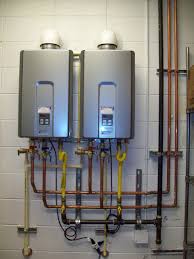Tank vs. Tankless Water Heaters
If you need to replace your water heater, here is some helpful advice on the difference between a tank and a tankless water heater.
The Advantage of Tankless Water Heaters

Tankless water heaters are usually installed in a basement and they are able to deliver multiple gallons of hot water at once. This provides an advantage of conventional water heaters as there is no waiting time for the water to heat up.
Tankless water heaters do not hold hot water, which means that they deliver hot water whenever you need it. Simply turn on the faucet and water is heated and delivered quickly.
The Disadvantage of Tankless Water Heaters
Although tankless water heaters are able to produce hot water consistently, they cannot produce a large amount at one time. This can cause a bit of shock midway through a shower if someone else starts to use the hot water as well.
Tank water heaters typically generate 7.5 to 9.5 GPM of hot water, which is enough to shower, wash laundry and run a dishwasher at the same time. However, a tankless water heater only produces 2.5 to 5 GPM, which limits the amount of hot water that can be used at once.
If you are worried about water demand, it is possible to install multiple tankless water heaters along your plumbing system. You can install multiple units or even have dedicated units for specific uses.
In summary, a large tank water heater can cover all of your hot water needs, but there is also significant energy losses when hot water stands in the tank. If you bring hot water close to where it’s needed, you lessen energy loss and raise efficiency by 50% over a traditional hot water tank system.
By installing tankless water heaters closer to where it is needed, you can reduce energy loss and increase efficiency by 50% in comparison to tank water heaters.
If you require assistance with a tank or tankless water heater, All Area Appliance is there to help you with your water heater installation and repairs in Denver.


